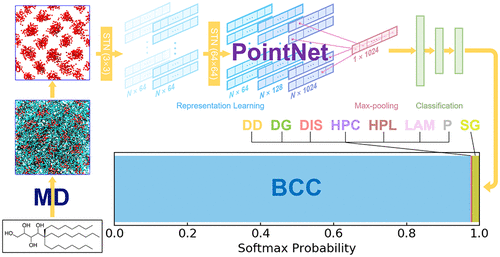J. Phys. Chem. B 2021, 125, 20, 5275–5284 (2021)
Molecular simulations with atomistic or coarse-grained force fields are a powerful approach for understanding and predicting the self-assembly phase behavior of complex molecules. Amphiphiles, block oligomers, and block polymers can form mesophases with different ordered morphologies describing the spatial distribution of the blocks, but entirely amorphous nature for local packing and chain conformation. Screening block oligomer chemistry and architecture through molecular simulations to find promising candidates for functional materials is aided by effective and straightforward morphology identification techniques. Capturing 3-dimensional periodic structures, such as ordered network morphologies, is hampered by the requirement that the number of molecules in the simulated system and the shape of the periodic simulation box need to be commensurate with those of the resulting network phase. Common strategies for structure identification include structure factors and order parameters, but these fail to identify imperfect structures in simulations with incorrect system sizes. Building upon pioneering work by DeFever et al. [Chem. Sci.2019, 10, 7503–7515] who implemented a PointNet (i.e., a neural network designed for computer vision applications using point clouds) to detect local structure in simulations of single-bead particles and water molecules, we present a PointNet for detection of nonlocal ordered morphologies of complex block oligomers. Our PointNet was trained using atomic coordinates from molecular dynamics simulation trajectories and synthetic point clouds for ordered network morphologies that were absent from previous simulations. In contrast to prior work on simple molecules, we observe that large point clouds with 1000 or more points are needed for the more complex block oligomers. The trained PointNet model achieves an accuracy as high as 0.99 for globally ordered morphologies formed by linear diblock, linear triblock, and 3-arm and 4-arm star-block oligomers, and it also allows for the discovery of emerging ordered patterns from nonequilibrium systems.
